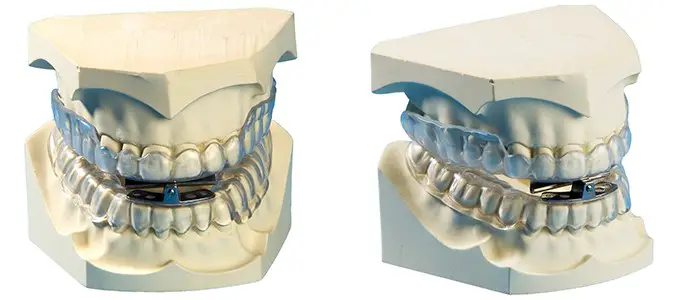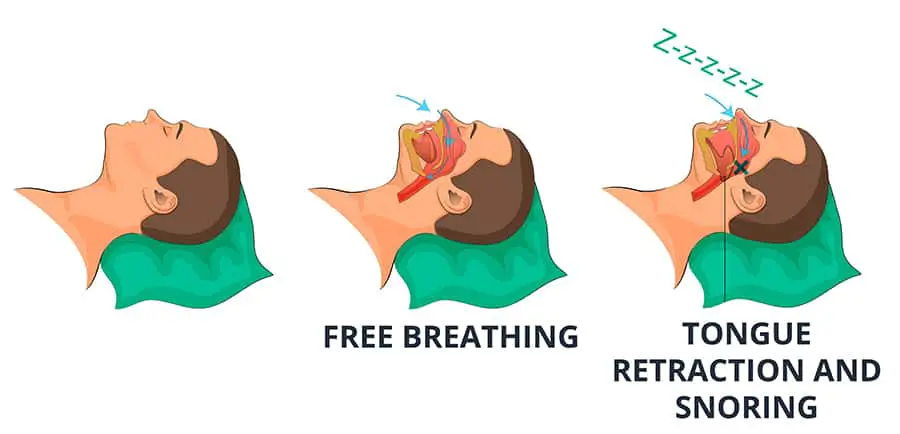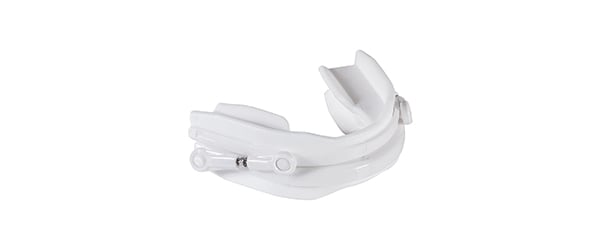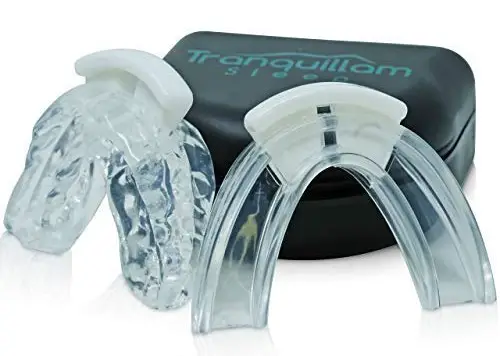
Mandibular Advancement Devices
Mandibular advancement devices (MAD) move the lower jaw forward to treat sleep apnea. Interestingly enough, moving our jaws forward has a huge impact on facial attractiveness. But the primary purpose of Mandibular Advancement Devices is a treatment for sleep apnea. Sleep apnea is known as a significant and potentially life-threatening disease that affects nearly 22 million people and counting. Many people rely on a machine that is attached to their nose while they sleep, but there are options such as go into the patient’s mouth while they sleep.
Mandibular advancement devices are used by many people that suffer from sleep apnea to move the lower jaw forward. It could potentially help with facial aesthetics. The devices are usually fitted to an individual’s mouth by an orthodontist or dentist.
However, there are some over the counter mandibular advancement devices that can be purchased. They are made to be worn during sleep only. The different options you may find when searching for the best device are:
- Custom
- Semi-Custom
- Boil and Bite
Using a Mandibular Advancement Device is one way that people suffering from sleep apnea can get a good night’s rest. In this article, you will learn about the devices that are available, how they work as well, and where to get them.
What is a Mandibular Advancement Device?
According to An Update on Mandibular Advancement Devices for The Treatment of Obstructive Sleep Apnoea Hypopnoea Syndrome, by Basyuni et al (2018), a Mandibular Advancement Device (MAD) is used to prevent airway collapse. It achieves this by forcing the mandible (or lower jaw) forward, which alters the position of the jaw and tongue. At first, this seems like it would be rather uncomfortable; however, the discomfort is usually temporary for users.
Types of Mandibular Advancement Devices
When looking at MADs, there are three separate options to choose from: custom, semi-custom, and boil and bite.
- Custom: Custom MAD’s are fitted by a trained orthodontist or dentist. The only way an individual can get a custom MAD is to receive a referral from a physician. When receiving a referral, most insurance companies will likely cover the cost of the device.
- Semi-Custom: A semi-custom MAD requires the user to take a mold of their mouth and send the mold away to a lab that will create a device based on the measurements of the mold. When the user receives the mold, if it does not fit correctly, it can be returned for alterations.
- Boil and bite: This device doesn’t require a physician’s referral to purchase and can be found in many drugstores or online stores. You simply boil water and submerge the device to soften the material. Once the material is cool enough, it needs to be placed into the mouth and bitten down on. By doing this, you can fit the device to your mouth. Most of the time, you can only mold the device one time, so if it does not fit properly, there may not be an option to refit the device.

Advantages and Disadvantages
Like any item you purchase, there are advantages and disadvantages to the various options of Mandibular Advancement Devices. When deciding which is best, it is essential to weigh the options. Ready-Made Versus Custom-Made Mandibular Repositioning Devices in Sleep Apnea: A Randomized Clinical Trial, by Ama Jical Trial et al (2017), explores the advantages and disadvantages of each.
| Device | Advantage | Disadvantage |
| Custom MAD |
|
|
| Semi-Custom MAD |
|
|
| Boil and Bite MAD |
|
|
Average Cost
As you can see from the above chart, there are several advantages and disadvantages to each MAD option. When looking at the options, you need to factor in your personal preferences as well as your ability to afford each option. The price varies significantly.
- For a custom fit MAD, you can expect to pay between $1,200 – $2,000.
- For a semi-custom-made MAD, you will likely pay between $75 – $100.
- For a boil and bite MAD, you can plan to spend $6 – $100.
When looking at the cost, you also need to factor in the time frame for replacing each device. If you choose an inexpensive over the counter version, you will likely be replacing it frequently, which will ultimately increase the amount of money you are spending. However, if you tend to lose or misplace things, you may not want to drop a ton of money on a custom device. The decision is ultimately yours.
Will Insurance Pay?
According to the American Sleep Association Question and Answers regarding Mandibular Advancement Devices, most insurance companies will help with medical sleep devices. However, there are often limitations as well as varying degrees to which they will be covered. Before you jump to get fitted for a custom device, you will want to check the insurance coverage you have. This will ensure you do not get a surprise bill when you receive your device.
Mandibular Advancement Devices and Facial Aesthetics
Mandibular advancement devices pull the lower jaw forward. As such, they can be used to treat underbites as well as other deformities according to Pliska et al. (2014):
Overbite and mandibular intermolar distance were observed to decrease less with time, while overjet, mandibular intercanine distance, and lower arch crowding all decreased continuously at a constant rate.
Keep in mind however that mandibular advancement devices push back on the maxilla, which is the most important bone for facial aesthetics. In addition, these devices are designed to help with sleep apnea, not to grow the jaw. This means that overusing the device in an attempt to get your jaw to grow could lead to TMJ issues and make your facial aesthetics even worse.
If you were to get a mandibular advancement device just for facial aesthetics, you would need to have a good reason such as overbite, overjet, or teeth crowding, and you would need to work with a physician to accomplish your goals. However, because the device pushes back on the maxilla, I would recommend looking into other options.
Mandibular Advancement Devices and Mewing
Mandibular advancement devices do not pair up well with mewing because by pushing forward on the mandible, the device pushes back on the maxilla. However, it’s also possible that if you are insanely good at mewing, you can counteract this. The problem is that at night, your muscles relax and the device will overpower your tongue.
I don’t recommend a mandibular advancement device for this reason. My first option would be merely to try mewing and see if you can get your soft tissues to change within several months. Merely pressing the tongue upward might be enough to get it out of the back of your throat and might fix your sleep apnea. If this doesn’t work, consider a surgery such as maxillary-mandibular advancement.
For more information on mewing and how it can help with sleep apnea, visit our Ultimate Mewing Guide.

Where Can I Purchase a MAD?
Because there are different options when it comes to choosing a MAD, there are also various options when it comes to purchasing the device. You have already learned about the different types of devices on the market and may be wondering how to get your hands on one for yourself.
Here is where you can find the different MAD options:
| Device | Where to Purchase |
| Custom Made MAD | This device can only be purchased from a licensed dentist or physician because it needs to be custom made and fitted for your needs. |
| Semi-Custom Made MAD | Typically, you can find an online retailer that specializes in these devices. You will order the molding kit and return it to them for a fitting based on your mouth structure. |
| Boil and Bite MAD | You can find this type of device at a local pharmacy such as Walgreens, CVS, or Rite Aid, and big-box retailers like Target or Walmart carry them as well. You will also notice several online retailers, too. |
Different Brands of Devices
There are many different brands of devices on the market that you can purchase. If you go to a dentist or orthodontist, they may have a specific brand they prefer over others. However true this may be, it is always advantageous to do your research before purchasing anything.
You will find there are many different devices on the market when it comes to Mandibular Advancement Devices. Here are three commonly found devices that may work for you:
- Sleep Apnea Goldilocks Appliance (SAGA)
- The SUAD Device
- Thornton Adjustable Positioner (TAP)
- Invisalign Mandibular Advancement
Each of these devices has its own unique characteristics that may make them favorable to the wearer.
Sleep Apnea Goldilocks Appliance (SAGA): This device is made of two vinyl liners that fully cover your top and bottom teeth. They allow the mandible to be adjusted forward to ensure proper airflow when sleep.
The SUAD Device: This device fits into the patient’s mouth and has the unique features of increased tongue space, as well as a cast-iron frame, which increases the durability of the device. If an individual has a larger tongue, this device would be particularly appealing to them. This device is especially useful for the grinding of teeth.
Thornton Adjustable Positioner (TAP): This device is the most prominent MAD on the market and is available in different options based on the user’s needs. The device is custom fit to the individual, and some models can even be adjusted while they are in the mouth by using an external key device. The main types of TAP devices are TAP and TAP 3.
- TAP: This version is the original device that was created to help with breathing during sleep. It fits into the mouth by firmly fitting around the top and bottom teeth, allowing the jaw to be moved gently forward. This device is likely not the most comfortable of options, but it will work to position the jaw for proper breathing while sleeping.
- TAP 3: This version of the device has been updated to be more comfortable to the user. It also allows the user to adjust the device while it is in the mouth. This allows maximum comfort and a custom fit for the wearer.
Invisalign Mandibular Advancement:
Invisalign can be used to correct teeth and expand your palate, much like braces. But now, it can also move your mandible forward. Visit the Invisalign website for more info.
The TAP models are also unique because they can be adjusted while the wearer is asleep. Often, when determining if an appliance is fitted and working correctly, the patient will be asked to undergo a sleep observation. During the sleep observation, if it appears the airway is not properly open, the physician or nurse monitoring the study can make the proper adjustments to the device without disturbing the patient. This allows the patient to receive the best fit to obtain optimal results.
The above model options are not available for purchase online or over the counter, which means they will likely cost more than boil and bite devices. However, if you have insurance to cover the cost or you do not mind spending extra money on a device, you can likely find one of the above options useful.

Boil and Bite MAD
After looking at the above options and seeing the time needed to receive the item as well as the cost associated with the product, you may be wondering how a boil and bite MAD works and if it will be a better option for you.
Here are some over the counter options that you can purchase online:
Tranquility Pro 2
Intelliguard Pro 2.0
Tranquillam Sleep
Serenity Bruxism
Bright Guard 2.0
JS Dental Lab
Each of these options is a cost-effective way to take advantage of a MAD in your own home without breaking the bank. Most companies provide both written and online tutorials to help guide you as you fit the guard to your mouth.

How to Fit The MAD
When you take the plunge and purchase a personal Mandibular Advancement Device, you need to know precisely how to use fit the device. Before beginning to fit the MAD, you need to gather the following materials:
- A heatproof dish that can hold enough water to cover the device.
- A pot or pan to boil water in
- A fork or heat resistant tool to remove the device from the water
- Water
Once you have gathered the appropriate materials, you are ready to begin fitting the device to your mouth. By following the steps below, you will have your MAD fitted in no time:
- Step 1 – Bring a pot or dish of water to a boil.
- Step 2 – Transfer the water to a heat resistant dish before submerging the mouthpiece. If you try to use the water in the pan, you will likely melt the device before you have an opportunity to shape it, and it will be rendered useless.
- Step 3 – Make sure the device is submerged in water for approximately 30-45 seconds or for the time designated by the manufacturer. Be sure you do not leave the device in the water longer than necessary, or you may ruin it.
- Step 4 – Remove the device from the water and allow it to cool to a temperature that is comfortable and safe to put in your mouth. When removing the device, be sure to use heat resistant tools, so you do not get burnt.
- Step 5 – Carefully place the device into your mouth and bite down, so your natural tooth pattern is imprinted into the device.
- Step 6 – Gently remove the device from your mouth, using caution not to bend the guard, which will lessen the integrity of the device.
- Step 7 – To set the mold, you have two options. You can let the device sit in a safe location until it cools, or you can run cold water over it.
By following these steps, you will likely have a MAD that fits well and serves it is intended purpose. If you find the fit to be uncomfortable, you may be able to remold it. However, many devices will only allow you to attempt the mold one time.
While these instructions and steps are quite standard, be sure to look at the specific manufacturer’s instructions to ensure you are following the correct steps. Not only is it essential to do this to ensure a proper fit, but it is also vital to maintain any warranties that may come along with the purchase of the device.

What are the Possible Side Effects?
As with many devices that are fitted into the mouth, there can often be side effects that accompany the device. According to The American Sleep Association (ASA), some common side effects are experienced by users of Mandibular Advancement Devices.
Some of the potential side effects are:
- A sore or stiff jaw
- Toothache
- Teeth moving out of alignment
- Painful wearing on the joints
- Excessive salivation
- Dry mouth
Most of the time, these side effects will resolve on their own as the individual becomes used to wearing the MAD; however, some side effects are significant and will not go away over time. For example, if the wearer experiences misalignment of the teeth or wearing of joints, they need to be in close contact with a dentist or orthodontist so they can help offer suggestions and relief.
Caring for Mandibular Advancement Devices
Once you have invested in a device, you want to ensure you are properly caring for it, which will help prolong the life of it. This is true whether you purchased either a low or high price model. The device will be spending lots of time in your mouth, so you want to make sure it is sanitized.
When determining the best method of cleaning, the most important thing is to look at the manufacturer’s guidelines as well as your dentist’s suggestions before you begin. Your dentist will likely provide explicit cleaning instructions as well as tools that you may need to use. To ensure the longevity of your device, it is not recommended that you use abrasive cleaning devices or tools.
Final Thoughts
When looking at the price of devices, do not be scared away by the sticker shock. If you have insurance and the referral of a physician, your insurance will likely cover the cost. No matter what decision you make, it is important to receive expert input and to research all the options you have available to you.
Mandibular Advancement Devices are widely used to treat snoring and other sleep apnea problems. While they are not necessarily a cure and may not be able to treat all forms of sleep apnea, they can often offer relief to the users, which often comes in the form of more restful sleep.
However, they can be damaging in the long term because of the fact that they push backward on your maxilla. This will hurt your facial aesthetics. It might force you to mouth breathe and end up leaving even less space in your mouth the more your maxilla gets pushed back.

